Volunteer Fire Fighter Dies and Another Fire Fighter is Injured During Wall Collapse at Fire at Local Business - Wisconsin
 Death in the Line of Duty…A summary of a NIOSH fire fighter fatality investigation
Death in the Line of Duty…A summary of a NIOSH fire fighter fatality investigation
F2001-09 Date Released: December 21, 2001
SUMMARY
On February 25, 2001, a 46-year-old volunteer Assistant Chief was fatally injured in a structural collapse at a local business. On February 25, 2001, at approximately 0450 hours, a resident notified the local Sheriff’s department of a structure fire at a local business. The first responding volunteer department responded to the fire at approximately 0500 hours. However, due to safety concerns by the local Sheriff’s Department, they were told to stage approximately ½ mile away from the fireground until it was deemed safe for them to begin fire suppression activities. Note: There were safety concerns from the sheriff’s department due to a domestic disturbance that occurred at this location earlier in the day. After the local Sheriff’s Department secured the scene, Volunteer Department #1 left the staging area and made their way to the fireground. At approximately 0600 hours, the Chief of Volunteer Department #1 assumed Incident Command (IC) and started an aggressive fire suppression operation. Volunteer Department #2 arrived on the scene at approximately 0610 hours and began assisting Volunteer Department #1 with fire suppression and water supply operations. Crews began to ventilate the structure by clearing windows. The IC then assisted a crew on the north side of the structure on a ladder to hit the fire through a window. The IC ordered crews to ladder the roof to try to force a door (hay loft) open to provide some vertical ventilation to assist suppression efforts. At approximately 0700 hours, Volunteer Department #3 was paged out to respond. At approximately 0745 hours, crews from Volunteer Department #3 arrived on the scene. At approximately 0752 hours, two fire fighters (the victim and the injured fire fighter) from Volunteer Department #3 were given an assignment by the Assistant Chief from Volunteer Department #1. The Assistant Chief instructed them to relieve the two fire fighters from Volunteer Department #1 on hoselines near the breezeway area. The victim and the injured fire fighter made their way to the door north of the breezeway to begin fire suppression. At approximately 0757 hours, the victim went into the structure approximately three steps to retrieve the nozzle, which was left just inside the doorway, and the injured fire fighter stayed in the doorway as backup. The victim started to back out of the structure when the injured fire fighter heard a series of cracks and yelled for the victim to exit. The injured fire fighter was approximately 2 feet from the structure and heard a “loud crack and a roar.” The exterior wall and roof collapsed outward and hit the injured fire fighter in the middle of his back (the top edge of the wall landed on the injured fire fighter’s SCBA cylinder) and pinned him face down in the snow. The victim was also pinned beneath the collapsed wall, approximately 2 feet behind and to the left of the injured fire fighter. At this time all fireground crews began extrication of the two trapped fire fighters. The injured fire fighter was removed from beneath the wall, placed on a backboard, and taken to the hospital. Crews began placing cribbing and air jacks to assist in the removal of the victim. At approximately 0825 hours, crews were able to remove the victim from beneath the debris. The victim was loaded onto a backboard, placed in an ambulance and transported to a nearby hospital. The victim was then air lifted to a regional trauma center where he died the next day. NIOSH investigators concluded that, to minimize the risk of similar incidents, fire departments should
- ensure that a collapse zone is designated and monitored to ensure that no fire fighting operations take place in the danger zone
- evaluate the risk versus gain when deciding on an offensive or defensive fire attack
- ensure that the Incident Commander remains at the command post for the duration of the fire or until he/she is relieved of his/her position
INTRODUCTION
On February 25, 2001, six volunteer fire departments responded to a structure fire at a local business. The fire was determined to be arson by the State Fire Marshal. A 46-year-old Assistant Chief (the victim) was fatally injured when an exterior wall and roof collapsed outward and pinned him underneath. An Engine Operator sustained non-fatal injuries. On February 27, 2001, the United States Fire Administration notified the National Institute for Occupational Safety and Health (NIOSH) of the incident. On March 19, 2001, two Occupational Safety and Health Specialists from the NIOSH Fire Fighter Fatality Investigation and Prevention Program investigated the incident. Interviews were conducted with the Chiefs from two of the responding departments and firefighters who were on the scene of the incident. A meeting was conducted with the State Fire Marshal. Video footage and photographs of the incident site, a map of the fire scene, a copy of the State Fire Marshal’s report, training records, the death certificate, and information from the local Sheriff’s Department were reviewed. The incident site was visited and the fire scene was photographed.
The structure involved in this incident was a single-story, ordinary construction, wood frame building. The structure had a restaurant at the south end and a gift shop/antique store at the north end. The structure measured 115 feet in length, by 52½ feet in width. The north end of the original structure was used as a barn and had been remodeled over the years. The south end of the structure was an addition that was added onto the structure as a restaurant.
The volunteer department involved in this incident consists of one station and 26 uniformed fire fighters. The department serves a population of 4200 in an area of 25 square miles. At the time of the incident the victim was wearing his self contained breathing apparatus (SCBA) along with his full complement of personal protective clothing and equipment.
The weather conditions at the time of the incident included an ambient air temperature of 32″ F, freezing rain and snow covering the roadways, approximately 6 inches of snow covering the ground, winds from the west with a speed of 6.9 mph, and a barometric pressure of 29.09. The victim had 6 years of fire fighting experience. The injured fire fighter had 6 years of fire fighting experience.
Fire fighter training in the state of Wisconsin is regulated through the Department of Commerce and training is conducted through the Wisconsin Technical College System (WTCS). The State requires volunteer fire fighters to complete the entry level fire fighter parts I and II. The course is based on the 4th Edition of the International Fire Service Training Association (IFSTA). Upon completion of entry level fire fighter parts I and II, volunteer fire fighters are then eligible to complete the National Fire Protection Association (NFPA) Level I training.
INVESTIGATION
On February 25, 2001, at approximately 0450 hours, a resident notified the local sheriff’s department of a structure fire at a local business. At approximately 0500 hours, Volunteer Department #1 was notified by Central Dispatch and subsequently responded to the alarm. Volunteer Department #1 responded to the scene at approximately 0545 hours with 16 Fire fighters (one engine, two tankers, and one medical/rescue unit). However, due to safety concerns by the local Sheriff’s Department, they were told to stage approximately ½ mile away from the fireground until it was deemed safe for them to begin fire suppression activities. The departments staged for approximately 45 minutes before entering the fireground Note: There were safety concerns from the police department due to a domestic disturbance that had occurred at this location earlier in the day. After the local police department secured the scene, Volunteer Department #1 left the staging area and made their way to the fireground. At approximately 0600 hours, the Chief of Volunteer Department #1 assumed Incident Command (IC) and started an aggressive fire suppression operation. Upon completion of his walk-around of the structure, the IC assigned crews to stretch two attack lines, one 2 ½-inch line and one 1 ¾-inch line to the restaurant area (breezeway) of the structure. Crews attacked the fire from the exterior, directing their lines through the breezeway door (Diagram 1). Note: The section of roof over the restaurant area of the structure had already collapsed due to heavy fire inside the structure. Volunteer Department #2 arrived on the scene at approximately 0610 hours and began assisting Volunteer Department #1 with fire suppression and water supply operations.
The IC then assigned crews to the west side of the structure (kitchen area), the south side of the structure, and two crews near the front of the structure to keep the fire from spreading into the antique/gift shop area (Diagram 1). Crews began to ventilate the structure by clearing windows. The IC then assisted a crew on the north side of the structure on a ladder to hit the fire through a window. The IC ordered crews to ladder the roof to try to force a door (hay loft) open to provide some vertical ventilation to assist suppression efforts. The crew could not force the door open and the IC ordered them to exit the roof. Crews on the north side forced a pedestrian door open on the northeast corner of the structure and entered to check for fire extension. Crews exited and reported that there was no extension inside the antique/gift shop area of the structure. Crews placed a positive pressure ventilation (PPV) fan in the northeast doorway. The crews walked inside the structure about two-thirds of the way into the gift shop area and continued to search for fire extension, then exited. All fireground crews held their positions on the exterior of the building performing a defensive fire attack. At approximately 0745 hours, the first unit from Volunteer Department #3 arrived on the scene. Volunteer Department #3 responded with 11 fire fighters and the following apparatus: one engine (Engine 5), two tankers, and Rescue Truck #3. Volunteer Department #3 set up Rescue 3 (their cascade unit) to fill Self Contained Breathing Apparatuses (SCBA). At approximately 0752 hours, two fire fighters (the victim and the injured fire fighter) from Volunteer Department #3 went to the Assistant Chief from Volunteer Department #1 to be given an assignment. The Assistant Chief instructed them to relieve the two fire fighters from Volunteer Department #1 on a 1 3/4-inch handline near the breezeway area. The victim and the injured fire fighter made their way to the door north of the breezeway to begin fire suppression. At approximately 0757 hours, the victim went into the structure approximately three steps to retrieve the nozzle, which had been left just inside the doorway, and the injured fire fighter stayed in the doorway as backup. The victim and the injured fire fighter held their position on the outside of the structure for approximately 2 minutes. The victim started to back out of the structure, and the injured fire fighter heard a series of cracking sounds and yelled for the victim to exit. The injured fire fighter, approximately four steps from the doorway, again heard a loud cracking sound and yelled again to the victim to exit. The injured fire fighter turned to look for the victim and saw the victim was following him away from the structure. The injured fire fighter was approximately 2 feet from the structure when he heard a “loud crack and a roar.” The wall collapsed outward, hitting the injured fire fighter in the middle of his back (the top edge of the wall landed on the Injured Fire Fighter’s SCBA cylinder) and pinned him face down in the snow. The victim was pinned beneath the collapsed wall, approximately 2 feet behind and to the left of the injured fire fighter. As fireground crews came to help remove the injured fire fighter and the victim, the injured fire fighter tried to push his way out from beneath the collapsed wall, but he was unable to move. Fireground crews began digging snow from around the injured fire fighter, and additional crews tunneled their way under the collapsed wall to the victim. Crews began cribbing the wall to remove the injured fire fighter. They also began cribbing and setting air jacks in place to assist in the removal of the victim. The injured fire fighter was removed from beneath the wall approximately 10 minutes after the collapse. The injured fire fighter stood up and crews helped remove his gear. Emergency Medical Service (EMS) crews put a cervical collar on him and placed him on a backboard and loaded him into an ambulance. Two Fire Fighter/Emergency Medical Technicians then went under the wall to assess the victim. He was found to be unresponsive and did not have a pulse. At approximately 0825 hours, fire fighters were able to raise the collapsed wall enough for crews to pull the victim out by his SCBA harness. The victim was immediately rolled onto his back, and an oral airway was established. The victim was then placed on a backboard, loaded into an ambulance, and taken to the hospital. The injured fire fighter was loaded into an ambulance and also taken to the hospital. The victim was then air lifted to a regional trauma center where he died the next day. The injured fire fighter was treated at the hospital and released.
CAUSE OF DEATH
The death certificate lists the cause of death as anoxic encephalopathy and chest compression asphyxia.
RECOMMENDATIONS/DISCUSSION
Recommendation #1: Fire Departments should ensure that a collapse zone is designated and monitored to ensure that no fire fighting operations take place in the danger zone. 1
Upon arrival, if structural integrity is questionable, a zone of danger needs to be established. When the department arrived on the scene, a section of the roof had already collapsed due to the conditions.
The zone of danger contains two types of hazards, horizontal collapse zone and vertical collapse zone
Horizontal Collapse Zone: “The horizontal measurement of the wall. When establishing a collapse zone, fire fighters should estimate this measurement in addition to the outward area that the wall may cover if it falls. A miscalculation of the potential horizontal length of a wall collapse could be just as deadly as a miscalculation of the outward area a falling wall will cover with masonry.”
Vertical Collapse Zone: “The expected ground area that a falling wall will cover when it collapses. It is generally that distance away from the wall equal to the height of the wall. In some instances, heavy stones will fall farther than this distance.” (See Figure 1)
In this incident, the fire departments were forced to stage approximately ½ mile away from the structure due to concerns for personal safety. This staging area did not allow the Incident Commander (IC) to see the fireground, hindering his size-up of the structure to develop a plan of attack. The departments staged for approximately 45 minutes before entering the fireground. This delayed the departments’ fire suppression operations allowing the fire to spread and intensify. In this incident, approximately one-half of the building was fully involved when the department arrived on the scene, and the section of the roof over the restaurant had already collapsed due to heavy fire inside of the structure. After a proper size-up is conducted, designated collapse zones need to be established by the Incident Commander and crews kept a safe distance away from the building. In addition, suppression efforts should be continued in a defensive effort.
Recommendation #2: Fire Departments should evaluate the risk versus gain when deciding an offensive or defensive fire attack.2
The Fire Ground Commander (FGC)/Incident Commander (IC) must consider, upon arrival and throughout the incident, whether the operation is to be conducted in an OFFENSIVE OR DEFENSIVE mode. He should extend an offensive attack only wherever and whenever conditions permit and adequate resources are available. This is a critical command decision, leading to the selection of two strategies:
Offensive Strategy: Interior attack, with related support, to quickly bring the fire under control.
Defensive Strategy: Exterior attack, with related support, to stop forward progress and then to control the fire. The first defensive tactic is to protect the exposures.
The FGC decides if a situation is in the offensive or defensive mode through the analysis of seven fireground factors and their related characteristics.
1. Fire Extent and Location – How much of the building and what part of the building is involved?
2. Fire Effect on the Building – What are the structural conditions?
3. Savable Occupants – Is there anyone alive to save?
4. Savable Property – Is there any property left to save?
5. Entry and Tenability – Can fire forces get into the building and stay in?
6. Ventilation Profile – Can truck crews conduct roof operations?
7. Resources – Are sufficient resources available for the attack?
This command decision is an ongoing one, requiring the FGC to reconsider these seven, major factors throughout the attack. For example, the decision to begin, or continue a defensive attack mode, may be based on the fact that the offensive attack strategy has been abandoned (if it was ever begun) for reasons of personnel safety, and the involved structure has been conceded as lost.”2
Recommendation #3: Fire Departments should ensure that the Incident Commander remains at the command post for the duration of the fire or until he/she is relieved from his/her position. 3
As stated in Incident Management for the Street-Smart Fire Officer3, Command is defined as the person ultimately responsible for the outcome of the incident – the individual who sets the tone for the incident and defines strategies. The basic premise behind the Incident Management System (IMS) states: One individual shall be in charge of every incident. This individual has been referred to by several titles in the past. What is vitally important is that
-
- One – and only one- individual be in charge,
- Everyone responding (or who could respond, as in mutual aid) knows what the individual in charge is called, and
- No one does anything until that person directs him to do it.
In this incident, due to circumstances surrounding the fire, the Incident Commander (IC) was not able to set up a designated command post. Note: The police department made the decision to keep crews off the fireground due to safety concerns from a domestic disturbance that occurred earlier in the day at this location. When crews were allowed to enter the fireground, command decided to use a fast attack to try and contain the fire to the southeast section of the building. The Incident Commander assisted crews with ventilation and suppression, in efforts to contain the fire. This prevented him from setting up or remaining at the command post while fireground crews were operating. Command should also consider the location of the command post to ensure the location is advantageous for focusing on the whole incident; the larger the incident, the farther away the command post should be.2 When the collapse occurred the IC was at the northeast corner of the structure assisting crews in suppression activities. From this corner of the building the IC was unable to see the front of the structure, where the collapse occurred.
REFERENCES
1. Dunn V [1988]. Collapse of burning buildings, a guide to fireground safety. Saddle Brook, NJ: Fire Engineering Books and Videos.
2. Brunacini A V. [1985]. Fire command. Quincy, MA: National Fire Protection Association.
3. Coleman. [1997]. Incident management for the street-smart fire officer. Saddle Brook, NJ: Fire Engineering Books and Videos.
INVESTIGATOR INFORMATION
This incident was investigated by Tom Mezzanotte and Jay Tarley, Occupational Safety and Health Specialists, NIOSH, Division of Safety Research, Surveillance and Field Investigations Branch.
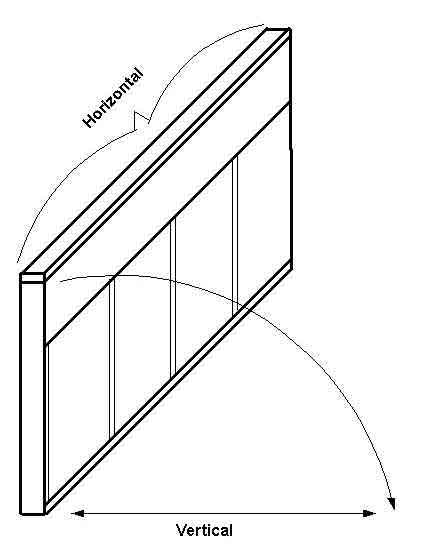
Figure 1. Zones of Danger: Collapse Danger Zone
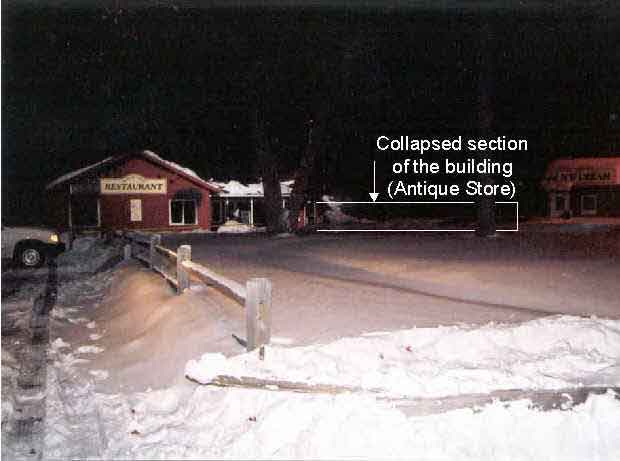
Photo 1. Incident Site
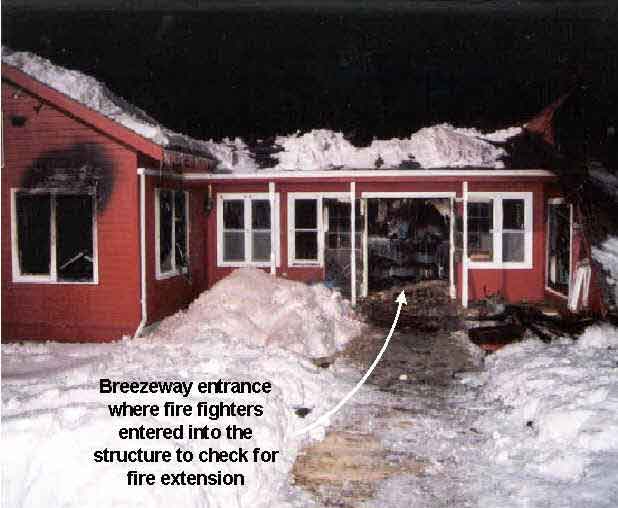
Photo 2. Incident Site
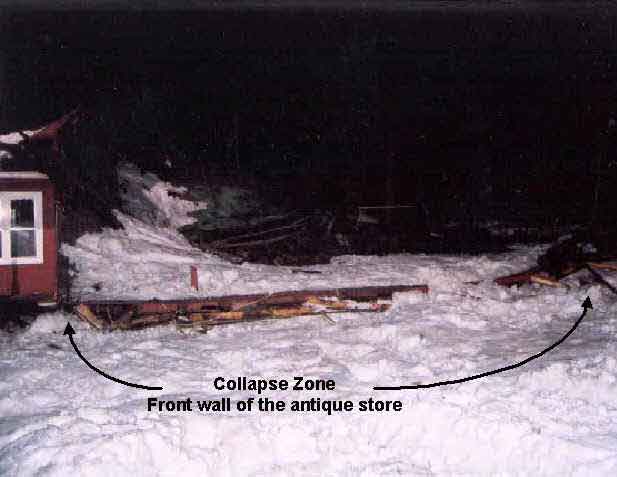
Photo 3. Incident Site
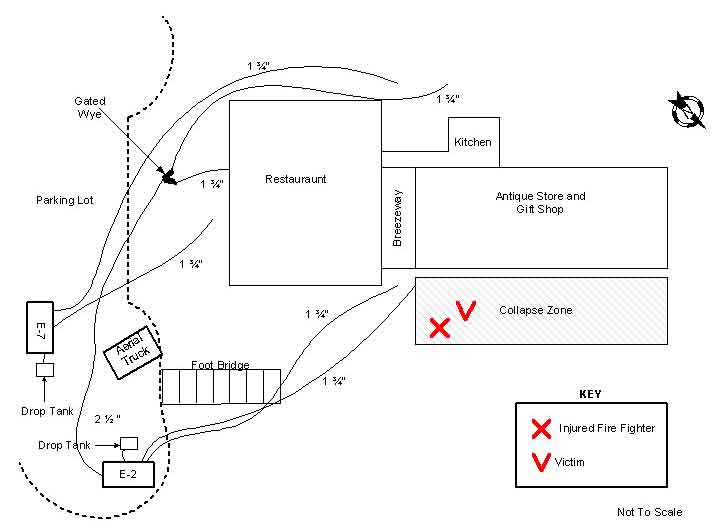
Diagram 1. Incident Site
This page was last updated on 1/10/02
